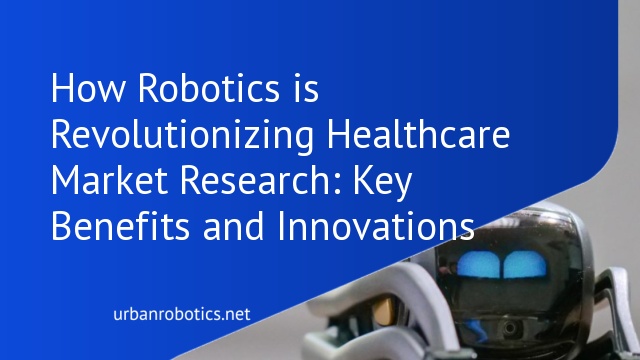Understanding Healthcare Market Research
Healthcare market research involves gathering, analyzing, and interpreting data to gain insights into market dynamics, patient behaviors, and industry trends. With advancements in robotics, this research becomes even more precise and efficient.
Importance of Market Research in Healthcare
Market research in healthcare identifies industry trends, evaluates patient needs, and optimizes resource allocation. Accurate data enables healthcare providers and stakeholders to enhance patient care and tailor strategies. Pharmaceutical companies, for instance, rely on market research to develop effective drugs and reduce time-to-market, improving public health outcomes.
Current Challenges in Traditional Methods
Traditional methods face limitations in data collection, processing speed, and accuracy. Manual data collection is time-consuming and prone to errors, which affects the quality of insights. Additionally, survey respondents may provide biased or incomplete information. These challenges hinder the ability to make data-driven decisions, delaying the implementation of necessary changes.
Introduction to Robotics in Healthcare
Healthcare market research has seen significant advancements with the integration of robotics. Various types of robotics are employed to streamline data collection and improve care delivery.
Types of Robotics Used
There are multiple types of robotics used in healthcare market research. Surgical robots aid in precision and minimally invasive procedures. Telepresence robots facilitate remote consultations and patient monitoring. Autonomous mobile robots (AMRs) assist in logistics and supply chain management within hospitals. Each type improves specific aspects of healthcare, resulting in comprehensive data collection and enhanced patient outcomes.
Benefits of Robotics in Healthcare
Robotics in healthcare offer several benefits. They enhance the accuracy and speed of data collection, leading to more reliable market research. Robots reduce human error, increasing the precision of surgical procedures and patient monitoring. They also improve workflow efficiency, enabling healthcare professionals to focus more on patient care. These benefits help healthcare organizations make informed decisions, ultimately leading to better patient care and optimized resource allocation.
Robotics Enhancing Market Research
Robotics have transformed the landscape of healthcare market research. They bring unprecedented accuracy, efficiency, and depth to data-driven insights.
Data Collection and Analysis
Robotics streamline data collection and analysis by automating repetitive tasks. Surgical robots, for example, gather real-time data during procedures, reducing error and enhancing data reliability. Autonomous mobile robots (AMRs) navigate healthcare facilities to collect and analyze environmental data. This technology enables faster data processing and improved accuracy, providing valuable insights quickly and effectively.
Patient Monitoring and Feedback
Robotics play a key role in patient monitoring and feedback. Telepresence robots enable remote interactions, facilitating continuous patient monitoring without physical presence. They gather data from patients’ homes, providing healthcare professionals with timely and accurate feedback. This real-time data helps in understanding patient experiences and improving care plans, thereby enhancing overall healthcare quality.
Predictive Analytics
Robotics contribute significantly to predictive analytics in healthcare. Integrating robotics with AI helps analyze vast datasets to predict trends and outcomes. For instance, machine learning algorithms applied to data from robotic-assisted procedures can forecast recovery times and potential complications. This predictive capability aids in preemptive decision-making, optimizing patient care and resource allocation in healthcare settings.
Case Studies and Real-World Applications
Robotics in healthcare market research has produced tangible benefits and various successful implementations. Here, we explore how these technologies have been applied effectively.
Successful Implementations
In the United States, Johns Hopkins Hospital integrated surgical robots, enhancing the precision of complex procedures. The Mayo Clinic utilized telepresence robots for remote consultations, boosting patient access to specialists. Autonomous mobile robots in Cleveland Clinic facilities streamlined logistical tasks, reducing staff workload and errors. These implementations illustrate robotics’ transformative power in healthcare settings.
Lessons Learned
The adoption of robotics in healthcare has provided valuable insights. Staff training and adaptation proved essential for successful integration. Data security emerged as a critical consideration, requiring robust cybersecurity measures. Additionally, ongoing maintenance and updates are vital to keep robotic systems functioning optimally. These lessons emphasize the importance of preparation and continuous evaluation.
Future Trends in Healthcare Market Research with Robotics
Robotics continues to advance rapidly, shaping the future of healthcare market research. Emerging technologies and the potential challenges they bring will redefine research methodologies.
Emerging Technologies
Integration of robotics with AI and machine learning is enhancing precision in data collection and analysis. We see developments in nanorobots for targeted therapies and microbots for intricate procedures. Social robots are increasingly used for patient interaction, providing valuable behavioral data. Advanced telepresence robots allow for more efficient remote consultations, while autonomous robots aid in logistical tasks, streamlining operational efficiencies.
Potential Challenges and Solutions
Robotic adoption in healthcare faces technical and ethical challenges. Data privacy remains a top concern due to extensive data collection by robots. Implementing stringent data security measures ensures compliance and patient trust. High costs of advanced robotics can impede adoption; partnerships between tech companies and healthcare providers can alleviate financial strain. Additionally, integrating robotics requires robust staff training programs, which enhance operational efficiency and mitigate risks associated with technological implementation.
Conclusion
Robotics in healthcare market research is revolutionizing the industry by enhancing data accuracy and process efficiency. With applications ranging from surgical robots to AI-driven predictive analytics we’re witnessing unprecedented advancements in patient care. Despite challenges like data privacy and costs robust security measures and strategic partnerships are paving the way for seamless integration. Investing in staff training ensures that we can fully harness the potential of these technologies. As we continue to innovate the future of healthcare looks promising with robotics at the forefront.





